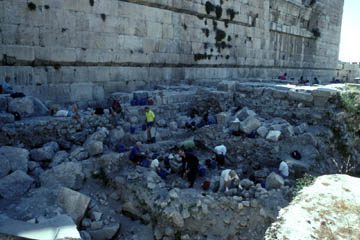It Doesn't Matter
Some years ago the Diggings team had the privilege of working at the Western Wall in Jerusalem. It was something of an odd experience.
A few yards to the north, on the other side of the earth ramp that led up to the Moghrabbin Gate by which tourists enter the Haram es-Sharif, Jews congregated in front of what they regard as the holiest spot on earth - the stones that form the western wall of Herod's temple destroyed by the Romans in AD 70. Men must cover their heads before they approach the Wall and the cracks between the huge stone blocks are crammed with written prayers left by devout worshippers who think that written appeals in the holy place are more likely to be noticed by God.
Even more curious is the fact that north of the Wall Plaza you have the vaults of Wilson's Arch, the first of which has been turned into a sort of synagogue. When Israeli archaeologists wanted to excavate along the line of the wall north of Wilson's Arch there was immediate uproar. Arabs, predictably, declared that it was a deep Jewish plot to desecrate or destroy the Haram as-Sharif. The top Jewish authorities, on the other hand, decided that the area was so holy that mere Jewish archaeologists were too unclean to handle the sacred dirt. Only black-clad yeshiva students in clumsy "bovver" boots were allowed to dig while the archaeologists sat on stools at a distance and shouted orders to dig here or sweep there.
Yet, for some strange reason, that very same wall and those very same stones bear no aura of sanctity south of the earth ramp. Jewish archaeologists, Palestinian labourers and us gentile volunteers scrabbled in the dirt, rested our sweaty backs against the Wall, and fossicked among stones thrown down from Herod's temple, within earshot of murmured prayers and the occasional blast on a shofar. Perhaps more to the point, none of us were smitten with lightning or stricken down by mysterious illnesses, which seems to indicate that irrespective of human opinions, our activities were not subject to Divine displeasure either!
Our task was to dig down through layers of occupational debris to the level of a Roman road which once ran along the bottom of the Tyropoean Valley and was spanned by Wilson's Arch. It was quite the most fascinating dig I have ever been on, as we found first fragments of Crusader pottery, then white cubes of stone, the tesserae from an Omayyid Palace floor. (Being good Muslims, the Omayyids didn't use mosaics to depict anything, so plain white floors were the order of the day.) Digging deeper we came to a Byzantine bronze coin, a tiny mite, the sort of coin given to the temple by the widow woman Jesus commended.

|
| The Diggings team excavates at the Western Wall in Jerusalem among the blocks of stone from the temple. |
All this had been piled up over the jumbled blocks of stone which had been thrown down into the valley by the Roman soldiers detailed to destroy the Jewish temple. More and more of these stones were revealed as we cleared away the dirt that covered them, but when we really got down among them we started to make even more evocative discoveries - a Roman arrow-head, a stone ball from a catapult, and finally a few pieces of human bone.
We never did get down to the level of the Roman road, which we could see clearly exposed in the areas excavated by other groups. That was left to the groups which came after us (today you can see the whole length of road, from where it disappears under the ramp at one end to where it vanishes under the Omayyid palace at the other. Every time I go to Jerusalem I peer over the low wall that surrounds the excavations and admire the place where we dug.
Unfortunately, I may not be able to do so much longer. The Western Wall Heritage Foundation has applied for permission to build over the road. The excuse is that they want to make a museum, a 4,800 square metre, three-story museum and educational institute that will "display" the Roman road. This is clearly a meaning of the word "display" that cannot be found in any normal dictionary: you "display" something by building a three-story building on top of it that hides all except a few yards of Roman paving.
Furthermore, the mere act of building on such an important archaeological site will inevitably result in damage to the site. Heavy construction equipment will do its own damage, but the foundations required for such a large building will also damage the site. Perhaps even worse, the presence of the building will make it impossible to dig beneath the road and discover what lies beneath it.
The Israeli Antiquities Authority claims that there is no problem with the proposed building, but this, according to Yoram Tsafrir, former archaeology professor at the Hebrew University of Jerusalem, is because the Roman road comes from the period after the destruction of Jerusalem - in other words, from Hadrian's city of Aelia Capitolina.
"One day, we can hope, the entire length of the road might be revealed," he told an archaeology conference in Israel. "That will be able to happen when more enlightened groups run the city and the country and the cultural treasures that are in it - those that understand that even monuments that aren't Jewish have significance."
© Kendall K. Down 2009





